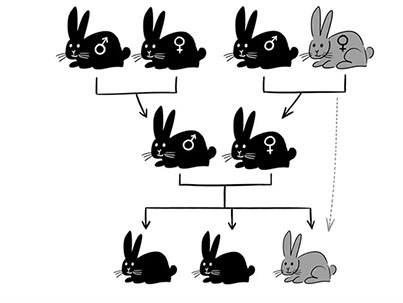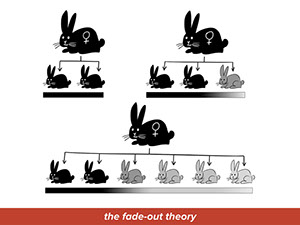SciGen Teacher Dashboard
Unit L3
Traits and Heredity
Scene: How Now Brown Bunnies?
 Duration: Approximately 50 minutes
Duration: Approximately 50 minutes
In this Science Scene, a dialogue to read aloud as a class, students play the roles of four friends who have been disappointed by a local school that promised to buy rabbits for every classroom. The friends learned to care for and breed rabbits in the hope of earning some money for their efforts. Their two black rabbits produced eight baby rabbits, but two of them were brown rabbits, and the students at the school had just read a story about cute black rabbits.
LEARNING OBJECTIVES
Students begin to learn how traits are passed from one generation to the next.
Teacher Tips
- Think ahead about how you will assign the three roles (Klent, Jordan, and Alexis), perhaps in groups or by having volunteers read in front of the class. Note that students often willingly take on roles regardless of the gender of the characters.
- While it is possible for the students to read the PDF of the script online, we suggest printing the script for the students so they can hold it in their hands and mark it as they read. Consider scaffolding the lesson for English language learners: you could let them preview the script before the lesson or read the dialogue silently once and ask questions to a partner.
- Prior to the reading the script, explain to students that they will encounter new vocabulary terms and ideas that may not be familiar. Reassure them that this lack of familiarity is okay. The reading is meant to introduce the ideas, not explain them completely.
- Review the focus words of the week. The focus word chart linked on the unit overview page should be used as a resource for students to review definitions and sample sentences.
- This activity is intended only as an introduction to the concepts.
- The genetics of rabbit fur color in NOT as simple as portrayed in this scene. The events are for illustrative purposed only.
Teacher Tune-ups
Teaching Notes
ACTIVITY OVERVIEW
- Set the context: Eye color (10 minutes)
- Engage with the script (20 minutes)
- Review five "theories" (10 minutes)
- Evaluate the characters' theories (15 minutes)
Set the context: Eye color (10 minutes)
Engage with the script (20 minutes)
You may want to assign students parts so they can read the scene aloud.
In this scene, four friends have been disappointed by a local school that promised to buy rabbits for every classroom. The friends learned to care for and breed rabbits in the hope of earning some money for their efforts. Their two black rabbits produced eight baby rabbits, but two of them were brown rabbits, and the students at the school had just read a story about cute black rabbits. Now, the four friends can’t sell their two brown rabbits! This leads to a discussion about how the two black rabbits could have produced brown rabbits, with several misconceptions offered by the friends. They then check the website suggested by the pet store and begin to learn about genes and dominant and recessive traits.
The Script: Black plus black make brown fur?
Setting: Keara’s backyard
Characters: Klent, Jordan, and Alexis
(Klent, Jordan, and Alexis push through the gate into Keara's backyard.)
Keara: Hey guys! How did the furry-friends sale go? Did you sell all of the rabbits to Ms. Tom, the principal at Dover Elementary?
Jordan: No, she only wanted the black ones.
Alexis: Three months ago Ms. Tom said she’d buy a rabbit for every class at Dover, but she didn’t say they had to be 100% black!
Klent: We sold Midnight and Jet and six of their babies that were all black. But we had to bring back Ajax and Poseidon, the two with chocolate brown fur. What’s with that? Everybody likes chocolate!
Jordan: What happened was all the kids read the book Race Down the Rabbit Hole.
Keara: Oh yeah, I read that when I was in elementary school. I remember the rabbit in that story was “black from the tips of his ears to the end of his tail.”
Jordan: You got it. So now the kids only want all-black rabbits.
Alexis: (sighing) That’s just great. Three months of work down the drain. We bought Jet and Midnight at the pet store; we fed them and cleaned the cages every day. We learned how to breed them. And then we took special care of Midnight and her eight kits.
Klent: I’d really like to know what’s with the chocolate fur anyway. The parents were all black. Not a spot of brown! But some of their baby kits are chocolate brown! How did this happen?
Alexis: Hey, maybe it’s like when the snowshoe rabbits turn white every winter to camouflage themselves against the white snow. Maybe a change in fur color is caused by the weather.
Jordan: No, I’m pretty skeptical about that explanation. If that were right they would all be the same color because they’ve all always lived in the same climate.
Klent: Maybe it’s like mixing paint colors together. You take the parents’ fur colors, blend them together, and—
Alexis. And you get six black kits and two brown kits? That can’t be right...I think maybe the color of the fur is made by a chemical. The mother has a limited amount to make into a color. Maybe she ran out of black? So the last ones born are kind of faded out?
Klent: Wait! I know! The brown ones have got to be MUTANTS! They were zapped by aliens or something!
Jordan: (rolled eyes) More like YOU were zapped by aliens.
Alexis: (changing the subject) Anyway...Ms. Tom said she would buy more all-black bunnies. So if we’re going to sell them, we’ve got to breed them. We better learn why an all-black dam and an all-black sire can have some kits that are chocolate.
Keara: Maybe that website the pet store told us about will have some info.
Jordan: Good idea. We should’ve read that before we first bought Jet and Midnight!
Rabbit Breeding and Genetics
A rabbit consists of many billions of tiny cells – skin cells, muscle cells, brain cells, plus cells of many other kinds – all cooperating to form the tissues and organs of the adult. Inside every rabbit cell is a set of long molecules called DNA. Every rabbit cell has the same set of DNA molecules, which it has inherited from the single fertilized egg cell that produced a small embryo through many cell divisions. Then, the embryo grew because of many more cell divisions and developed into the adult rabbit. Sections of each of the DNA molecules are called genes. Genes control how your rabbit turns out. The genes in the rabbit cells control traits such as fur color, eye color, and much more.
Jordan: Hey, now we’re getting somewhere. Genes are formed by DNA. Because every rabbit cell has the same DNA, the same genes are present throughout the entire rabbit body! Awesome!
Keara: Keep reading, Jordan.
Genes come in pairs. Plants and animals, including rabbits and people, get one copy of each gene from their mother and a second from their father. Copies of a gene for a particular trait may differ. The different versions of a gene are called alleles (uh-LEELS). So for example, a gene for eye color might come in an allele for green, an allele for brown, and so on. The two alleles for each gene from the parents are combined in the soon-to-be-born baby creature.
Keara: Wait! This is weird. Both Midnight and Jet are all black and both gave a gene for fur color to Ajax. So how come Ajax is brown?
Jordan: Chill out! Read this next part.
A common question is how can offspring have traits that neither parent has. To answer that, consider eye color in rabbits. Brown eyes are caused by brown pigment, while a lack of pigment makes the eyes look red. Brown eye pigment is a dominant trait in rabbits. That means if a rabbit has both an allele for brown eyes and also an allele for red eyes, the rabbits will still have brown eyes. The red-eye trait is recessive. The only way for a rabbit to have red eyes is for both alleles in the pair to be the recessive red-eye allele.
Klent: Recessive? Is that like a recess? The gene doesn’t have to go to class?
Keara: Uh, I don’t think so. It’s more like it’s in the background, I think.
Klent: And what does eye color have to do with fur color? (pauses) Wait a sec! I have blue eyes and both my parents have brown. I’ve always wondered how that works...
Jordan: I think it’s supposed to have something to do with your grandparents.
Klent: But I never even met my grandparents.
Jordan: No, what I mean is there’s a good chance one of them had blue eyes! My brother is really tall, and my Mom says my granddad was tall, but it skipped a generation.
Keara: I think I get it: somebody in a previous generation of Klent’s family had to have blue eyes for Klent to have that trait. Maybe fur color on rabbits works the same way.
Klent: I still don’t get how a grandparent’s eye color...
Alexis: Or fur color!
Klent: Fine! Eye color or fur color can jump over my parents and get to me from my grandparents. Seems too weird to be true.
Keara: So what are we going to do with Ajax and Poseidon? They’re too cute to be rejects.
Klent: Let’s go find a book about chocolate brown bunnies to read to those kids at Dover Elementary.
Review five "theories" (10 minutes)
When finished with the script, tell students that you have illustrations of 5 "theories" that were mentioned in the script
Project each theory and ask students to explain them to each other or to the class.
End with the question:
Can they all be right? (no)
Evaluate the characters' theories (15 minutes)
Next students work in pairs to identify the character who offered each theory for why the rabbits are brown and then consider the plausibility of the theory. You may want to explain to students that “plausibility” means believability: a theory is plausible if it has enough logic and evidence in its favor to make it believable. Students’ judgment of the plausibility of the different theories will vary.
Answers:
Weather theory (Alexis)
Fade-out theory (Alexis)
Blending theory (Klent)
Mutant theory (Klent)
Grandparent theory (Jordan)
BETA Version - Please send comments and corrections to info@serpinstitute.org





